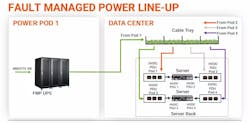ICT Engineering Experts Compare Class 4 Fault Managed Power vs. AC Power Infrastructure for Data Centers
Fault managed power (FMP) is a relatively new topic of conversation in information and communications technology (ICT) circles.
The recognition of Class 4 power in the 2023 National Electrical Code raised FMP’s profile, and the topic has been an agenda-topper for many ICT industry conferences, articles, and educational materials.
But the technology itself is more than a decade old and has in excess of a thousand deployments in multiple environments and applications.
On May 2, we at Cabling Installation & Maintenance, Data Center Frontier's sibling brand in Endeavor Business Media, hosted a webinar during which part of the discussion focused on the use of FMP in data centers.
The Practical, Technical, Economic Case for FMP
Known for being power-hungry facilities, data centers may not be the first environment that comes to mind when one thinks about FMP’s uses and capabilities.
But in this webinar—sponsored by VoltServer and delivered by VoltServer’s vice president of business and market development Ronna Davis, alongside Southland Industries’ principal electrical engineer Michael Starego—a practical, technical, and economic case was presented for using FMP in those spaces.
Specifically, Starego compared and contrasted the common alternating current (AC) power infrastructure for a data center, with that of an FMP-based infrastructure.
The above image is taken from Starego’s portion of the webinar presentation.
Also in his presentation, Starego delivered an analysis of powering a 6-megawatt data center using traditional AC versus using FMP.
That analysis includes a parts-and-labor summary that concludes the use of FMP can result in multiple-millions of dollars in savings.
The data center analysis occupied approximately 20 minutes of the hour-long webinar.
FMP and Digital Electricity
In the remainder of the time, VoltServer’s Davis discussed essentials of FMP technology and the relationship between FMP and Digital Electricity™.
Digital Electricity is a name trademarked by VoltServer; fault managed power is generic terminology for Digital Electricity. The two are often used interchangeably.
She also detailed the practicality of using FMP in other environments and applications, including campus and outdoor spaces, parking lots, shipping ports, airports, warehouses and distribution centers, office environments, and industrial plants.
If you are among the many ICT industry professionals who have not yet considered fault managed power as a potential energy source for a data center, investing one hour of time to watch the webinar could be worth your while.
The presentation is available for on-demand viewing through October 2024. You can register for and immediately begin watching the webinar here.
The VoltServer team showcased a tech demo at DCD Connect, illustrating for attendees just how safe Digital Electricity technology is, by doing something that makes all data center managers nervous—bringing water and electricity together.
About the Author

Patrick McLaughlin
Patrick McLaughlin is Chief Editor of Cabling Installation & Maintenance, Data Center Frontier's sibling publication in Endeavor Business Media. Patrick has covered the cabling industry for more than 25 years. He has authored hundreds of articles on technical and business topics related to the specification, design, installation, and management of information communications technology systems. He has presented at live in-person and online events, and he has spearheaded cablinginstall.com's webcast seminar programs for more than 15 years.



